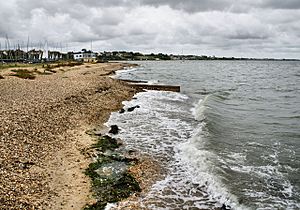Lee-on-The Solent to Itchen Estuary facts for kids
| Site of Special Scientific Interest | |

The beach at Titchfield Haven
|
|
| Area of Search | Hampshire |
|---|---|
| Interest | Biological Geological |
| Area | 585.9 hectares (1,448 acres) |
| Notification | 1992 |
| Location map | Magic Map |
The Lee-on-The Solent to Itchen Estuary is a very special place along the coast in Hampshire, England. It stretches between the towns of Southampton and Gosport. This area covers about 585.9 hectares, which is like 1,448 football fields! It's important for both its amazing wildlife and its ancient geology.
This coastal area is officially known as a Site of Special Scientific Interest (SSSI). This means it's protected by law because of its rare plants, animals, or geological features. It's also part of bigger protected areas like the Solent and Southampton Water Ramsar site and Special Protection Area. These are international agreements to protect important wetlands and bird habitats. It's also part of the Solent Maritime Special Area of Conservation, which protects important natural habitats and species across Europe.
Contents
What Makes This Place Special?
This site is a mix of different natural environments. You'll find large areas of muddy flats that are covered and uncovered by the tide. There are also saltmarshes, which are grassy areas flooded by saltwater. You can see shingle beaches with special plants, tall reedbeds, and even some forests with trees that lose their leaves in autumn. There are also areas of marshy grassland.
Amazing Wildlife
The Lee-on-The Solent to Itchen Estuary is a fantastic home for many creatures. It's especially important for some rare coastal plants that don't grow in many other places.
Birds to Spot
This area is a vital stop for many birds, especially during migration. It's internationally important for a type of goose called the dark-bellied brent goose. You might also spot other amazing birds like the great crested grebe, known for its fancy head feathers, and the ringed plover, a small bird that nests on beaches. In total, eight different bird species find this site nationally important for their survival.
A Peek into the Past
Beyond the living creatures, this site holds secrets from long ago. Scientists have found very old tools and objects here from the Stone Age. These give us clues about how ancient humans lived. The area is also famous for finding fossils of birds from the Eocene epoch. This was a time about 56 to 34 million years ago, when the Earth was much warmer!
Protected Areas Within the Site
Several parts of this larger special site have extra protection. These include three Local Nature Reserves:
These local reserves are great places for people to connect with nature and learn about conservation.
One historical spot within the area is Hamble Common Camp. This is a Scheduled Monument, which means it's an important historical site protected by the government. It helps us understand the past of this coastal region.

